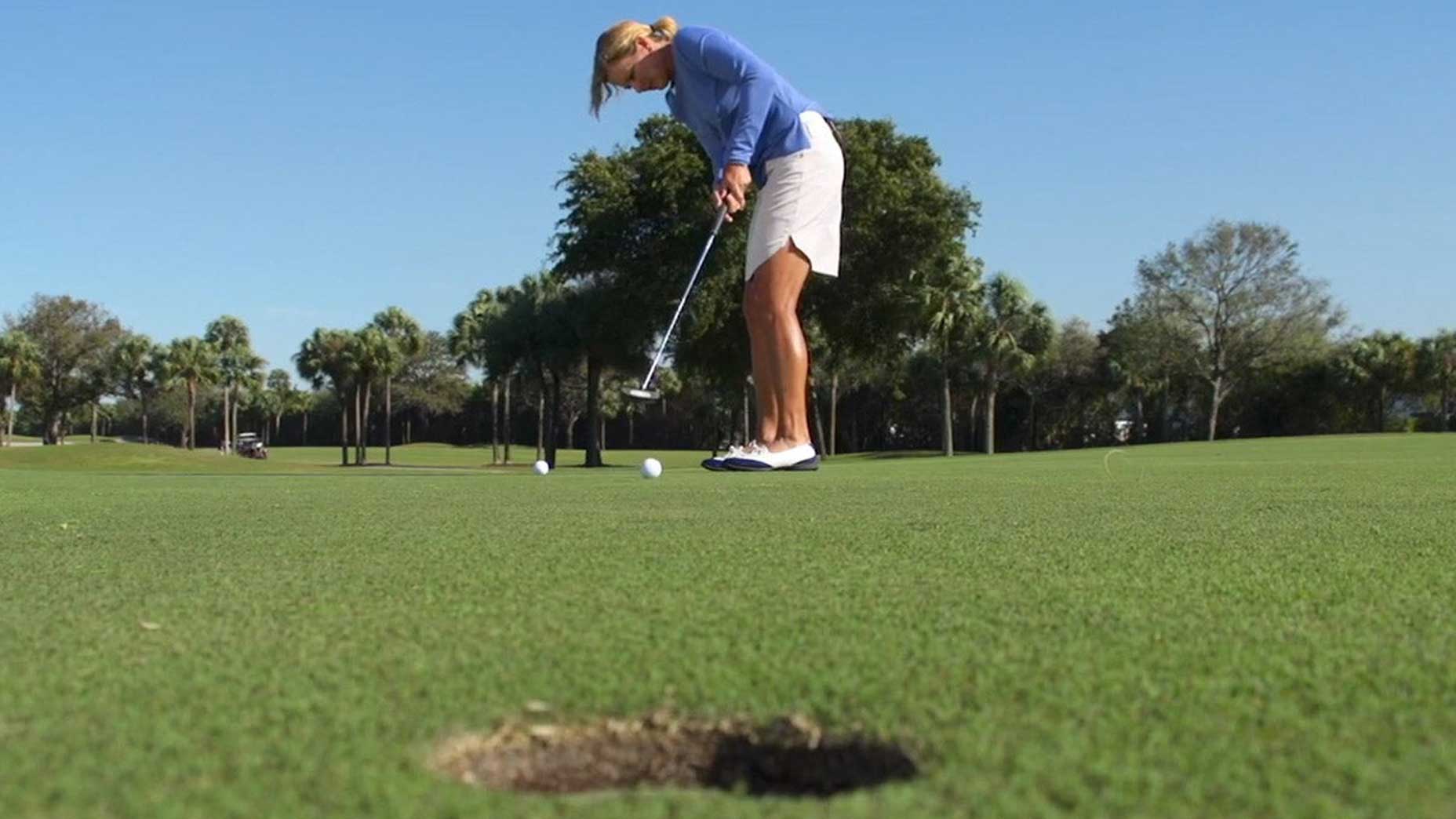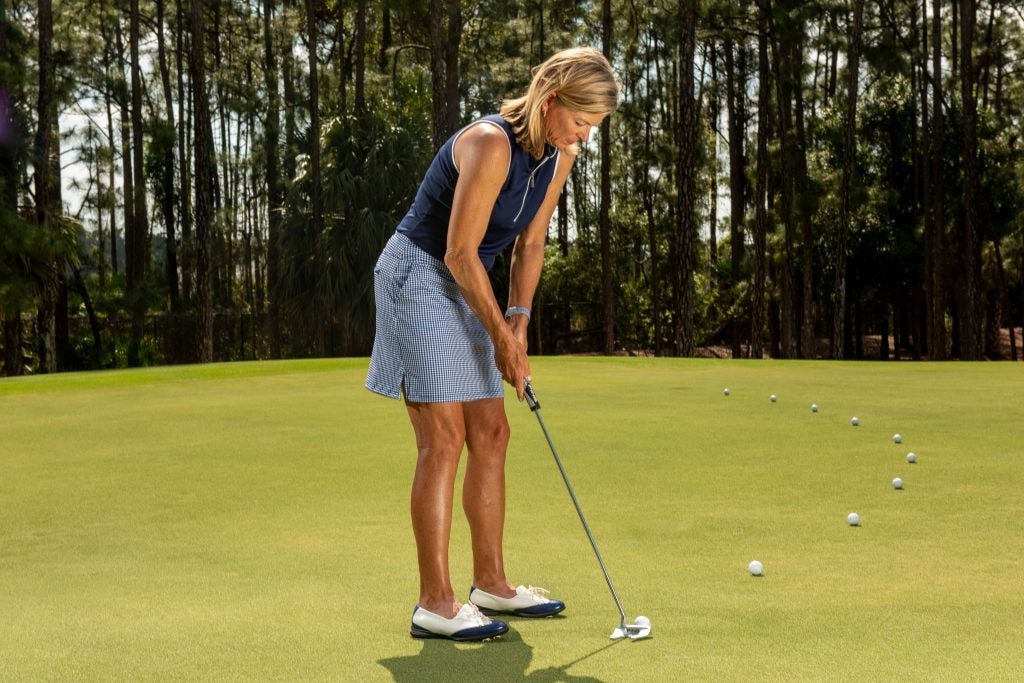It’s certainly fun to hit beautiful drives, fairway woods and iron shots. But the true art of being a good golfer comes when those things don’t happen.
Not only does chipping, pitching and bunker play require good technique, it also requires good decision making. Great players know how to avoid turning small mistakes into big ones by limiting risk and getting up and down.
Here are some tips to help improve your game around the green.

1. Putt whenever you can
Choosing to putt whenever you can is one of the greatest ways to limit risk when you miss a green, especially for high handicappers. It doesn’t require much — all you need most times is to open your mind to the possibility — and it’s a great option when your chipping isn’t in prime form.
When you’re farther away from the hole, and putting through slightly longer grass, you’ll obviously need to make your stroke longer. The larger the stroke, the more your putter falls, which will naturally deliver more speed and power into the golf ball.
2. A simple way to read greens
Reading greens is a skill that can be learned. I think the most important way to read greens, especially if you’re not sure where to start, is to ask yourself two simple questions:
First, is the putt uphill, downhill or flat?
Then, ask yourself: Which side of the putt is higher?
Sometimes longer putts can be all of these things at different points of the putt. In those cases, I suggest breaking the putt up into shorter sections. Pretend like one longer putt is three shorter ones; read each one individually, and put them all together later.

3. Speed is king on long putts
Being a good long putter is often about having the right goal and attitude. That means setting expectations. For long putts, your goal shouldn’t be to try to make it. That can lead to an overly aggressive attitude and lots of three-putts.
Direction is important, of course, but on long putts, the real key is speed. Really focus on getting your ball the right distance so it’s slowing down around the hole.
4. Stroke, then look on short putts
Short putts require the respect to run through your full routine and stay incredibly patient. I think a great attitude to have is to feel like you need to earn a hole-out on those short putts.
Another key component of this is waiting to turn your eyes to the hole. Complete your stroke first, keeping your body still, and listen to the ball go in rather than looking for it. Looking early can cause your body to move too much. You can start to look only when the putter stops moving.

5. Stroke size determines speed
Often I hear students say that they hit a putt too hard. But when a putt doesn’t roll the right distance, it’s because your stroke size was incorrect. It’s a helpful way to think about it.
One of my favorite drills, which I’m demonstrating above, is to set balls at 3-foot increments, starting with the shortest and working your way back. As you move, you’ll notice you progressively increase your stroke length.
6. Treat small chips like putts
Sometimes, putting isn’t your best options. Maybe you need to carry too much grass, rough or even a bunker, even though you’re still close to the hole.
My advice is to treat it like a putting stroke, but with a wedge. Take the same setup, with your weight forward, using the same back-and-through motion as a putting stroke. The ball will lift high because of the loft on the club, but the motion will be low maintenance.

7. Keep chipping small and simple
Call me super conservative, but I do not believe that if you are chipping with the right club, you need to have a big wristy motion. For higher handicaps, you need to keep the ball in play, which means using a smaller stroke with less change for error.
Ideally, you chipping stroke should hit the ground so the ball goes into the air, although it won’t go that high. For this, think about both your shoulders and your hands forming a triangle. Keep your weight forward, and the triangle intact throughout your chipping motion.
8. Setup determines good contact
As I’ve written about before, a good setup is so important to all golf skills. When you’re looking to be super accurate and consistent with your short-range shots, this is even more important. Please don’t undervalue how important your posture and stance can be.
Bow forward at your hips, and adjust your feet so your hands hang directly below your shoulders. For shorter shots, your feet should be closer together and weight more forward, but always balanced.

9. Use all your clubs
Once you’re good at one short-game shot, this is the one you should default to whenever you’re in doubt. When you need to hit the ball farther, I’d suggest using a different club with the same motion, rather than changing the motion with the same club.
I have learned over time that, as an instructor, this gives mid- and high handicaps a high level of success.
Once you determine your most comfortable stroke size, then grab all your irons and maybe even a hybrid and write down how far your golf ball travels, including roll.
10. Find a club that doesn’t dig
High-lofted shots around the green look great, but it’s not always the most prudent choice because of how risky they are. Sometimes pitching is a necessity, though, and for when it is, I suggest finding a club that doesn’t dig into the dirt too much.
Try different wedges, and opt for one with lots of bounce. A high-lofted club that glides through the turf and sends the ball into the air is ideal.
Need help unriddling the greens at your home course? Pick up a custom Green Book from 8AM Golf affiliate GolfLogix.
